August 23, 2021

Dairy market cows can contribute a healthy portion of income to the dairy operation. According to FarmBench, dairy cows sold for slaughter make up about 6.6% of total farm sales per year. To put that into perspective, a 250-cow dairy could see between $60,000 and $100,000 a year in market cow sales.
Not just a cull cow
Changing the mentality of what a cull cow means to dairy production is a step in the right direction to improving the kind of cow that leaves the farm. First and foremost, farmers should change their vocabulary when referring to a cull cow. “Cull” means to remove something inferior or worthless. Instead, these animals should be considered market cows, something with value.
Market cows leave the herd for many reasons. According to a 2014 Animal and Plant Health Inspection Service publication titled “Health and Management Practices on U.S. Dairy Operations,” the top reasons why dairy cows permanently left the herd were 16.5% because of mastitis, 21.2% because of infertility and 21.1% because of poor production. Lameness, aggressive behavior, respiratory disease and other diseases rounded out the most common reasons cows left the herd for slaughter.
Dairy producers must recognize the important part dairy cattle play in the beef industry and the important part beef plays on their farms. Contrary to popular belief, dairy cows aren’t only used for ground beef. Seventy-five percent of individual cow and bull carcasses are sold as whole cuts, specifically rear leg round cuts.
The 2016 National Beef Quality Audit showed that dairy cattle have over twice as many rear leg injection lesions as their beef counterparts. These lesions occur in the high-value rear leg muscle and must be cut out or discarded, in some cases significantly reducing the value of the carcass. Following Beef Quality Assurance recommendations and injecting cows in the low-value neck muscle will improve carcass quality.
While implementing BQA best management practices is important for preventing lesions and injection-site abnormalities, improving body condition score will produce a better overall market cow. The majority of cows leave the herd for reasons that don’t inhibit their ability to maintain a healthy BCS.
The 2016 NBQA showed that dairy cows at slaughter averaged a 2.3 BCS. The audit also showed 90% of dairy cows are too light muscled. Dairy farmers are leaving money on the table when they send cows with inadequate muscle and condition to market. According to the Dairy Animal Care and Quality Assurance Certification Program, the impact translates to an average loss to all dairy producers of $70 to $100 for every market cow sold. Individual per-cow losses can add up to more than $300, depending on the quality of the individual market cow. The NBQA stated that inadequate muscling is the second most significant reason carcasses lose value.
Market cow strategy
Improving market price and carcass value can be accomplished by developing a strategy for market cows. Once it is determined a cow will leave the herd, it should be evaluated for BCS and overall health. Holding market cows to gain weight can pay off in the end.
Cows will see the greatest rate of gain in 28 to 56 days. Extra refusals are cheap feed inputs, and dry matter intake should be 2.5% to 3% of body weight. While dry corn might not be economical to feed to market dairy cows, corn silage is plentiful and more affordable to feed. A 60% 80% grain diet should yield a 3-pound-per-day gain.
Understandably, dairy farmers may not have the space or resources to hold market cows for 60 days, but developing a strategy to improve carcass quality may be worth the extra effort.
Each packer or buyer is looking for a specific type of market cow. Some packers like leaner cows while some have a market for heavier cows. Regardless of what the packer is looking for, dairy cows should ideally never be below a 2.5 BCS. Improving the overall quality of the cow sent to market will produce a better price and a better carcass.
Bjurstrom is the Extension agriculture agent in Kewaunee County, Wis.
About the Author(s)
You May Also Like




